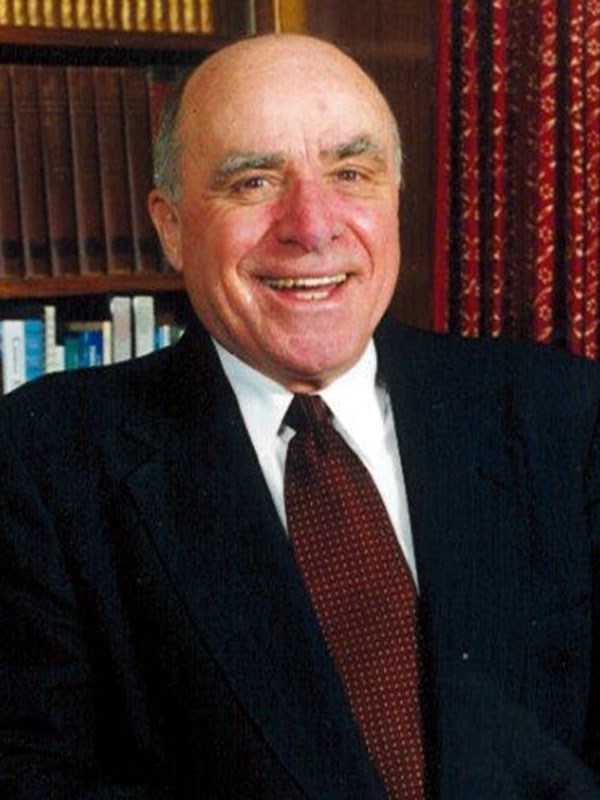
07/04/2017
The Lowell Sun
By Rick Sobey
LOWELL -- All across UMass Lowell's campus, buildings are named for different leaders and donors.
You may have walked past the Manning School of Business, Cumnock Hall or Cushing Field Complex.
While William Hogan's name is not displayed across a building -- partly because the former chancellor didn't want to be the center of attention and deflected credit -- he certainly laid the foundation for success across campus.
Hogan, known as the "Father of UMass Lowell" -- leading the university for 25 years and working there for more than four decades until 2006 -- died last week. He was 84.
"He was an institution," former Lowell state Sen. Steven Panagiotakos recalled on Monday. "UMass Lowell would not be where it is today without him setting the foundation."
Hogan, a former Chelmsford resident, is credited with making the school competitive on a national level, and for having a significant influence throughout Greater Lowell. Hogan was succeeded by Marty Meehan, now the UMass president.
Meehan stressed Hogan's "commitment to excellence" over the years.
"Bill had an extraordinary impact, building UMass Lowell into a research engine, which is so important today," Meehan said.
"I inherited from him a world-class faculty that was ready to get to the next level," Meehan added. "And we would have never been able to build buildings under my tenure without him being very fiscally conservative and prudent. He put us in a strong position to grow.
Born in the Lower Highlands, the son of a trolley and bus driver and stay-at-home mom, Hogan left AVCO Corporation in 1963 to teach mechanical engineering at what was then called Lowell Technological Institute.
At AVCO, Hogan directed a group of engineers responsible for the design, construction and evaluation of wind tunnels used to simulate space-vehicle re-entry into the earth's atmosphere for the purpose of heat-shield material evaluation.
"I could listen to his stories for hours about the early space program," said William O'Shea, a former UMass trustee. "He would talk about going down for engineering trips and launching rockets. And he'd talk about it and talk about it.
"He was a very, very special person," O'Shea added.
At Lowell Tech, he moved up the ranks to become head of the Mechanical Engineering Department, acting dean of engineering, and dean of the newly formed College of Engineering in 1973.
In 1975, Lowell Tech merged with Lowell State College to create the University of Lowell. Hogan was appointed the first vice president of academic affairs and served as president of the school for a decade.
During that time, then-math professor Tom Costello worked on creating the computer science department with Hogan.
"It was pretty clear to me that computer science was going to be very popular, so I nudged him a bit, and he was very supportive," said Costello, a retired professor and former vice chancellor. "Now today, computer science is a good, solid program at the university.
"He was a really straight shooter, and believed in building a real quality institution," Costello added.
Hogan then became chancellor when the school became part of the UMass system in 1991. As chancellor, he initiated a 10-year plan to improve the way the faculty teaches and the students learn.
Then he helped develop plans for a $266 million renovation of the school's three campuses. The renovation aimed to transform it into a bio- and nano-tech research and development center.
"He was a very driven man, and he had this vision that UMass Lowell could be the public MIT," said Chancellor Jacquie Moloney, who succeeded Meehan.
"Taking us from a teaching college and turning us into a research university was no small feat," she added. "He was a brilliant, brilliant man."
When Hogan retired in 2006, he said he was most proud that all major accreditations were retained. They include those from the Accreditation Board for Engineering and Technology and the National Council for Accreditation of Teaching Education.
While many college and university leaders stay at a job for about six years, Hogan's 25-year tenure was somewhat of an anomaly.
"A lot of them come and go, but this was his community. His life," Panagiotakos said. "He was really committed to the university being successful."
Hogan never hesitated to give back to the community. He was involved in the creation of LeLacheur Park, helped support the city's American League hockey team and developed a partnership between the university and the Lowell school system.
Meehan emphasized that the Tsongas Center and LeLacheur Park might not exist if Hogan didn't embrace the idea of including them into a partnership with the university.
"He made those projects happen," Meehan said.
"The university thrived and grew under him," the president added.
In his later years, Hogan lived in Alabama. His family could not be reached for comment on Monday.
Pine Crest Funeral Home in Mobile, Ala., is arranging his funeral.
